 W
WAn air brake or, more formally, a compressed air brake system, is a type of friction brake for vehicles in which compressed air pressing on a piston is used to apply the pressure to the brake pad or brake shoe needed to stop the vehicle. Air brakes are used in large heavy vehicles, particularly those having multiple trailers which must be linked into the brake system, such as trucks, buses, trailers, and semi-trailers, in addition to their use in railroad trains. George Westinghouse first developed air brakes for use in railway service. He patented a safer air brake on March 5, 1872. Westinghouse made numerous alterations to improve his air pressured brake invention, which led to various forms of the automatic brake. In the early 20th century, after its advantages were proven in railway use, it was adopted by manufacturers of trucks and heavy road vehicles.
 W
WAn anti-lock braking system (ABS) is a safety anti-skid braking system used on aircraft and on land vehicles, such as cars, motorcycles, trucks, and buses. ABS operates by preventing the wheels from locking up during braking, thereby maintaining tractive contact with the road surface and allowing the driver to maintain more control over the vehicle.
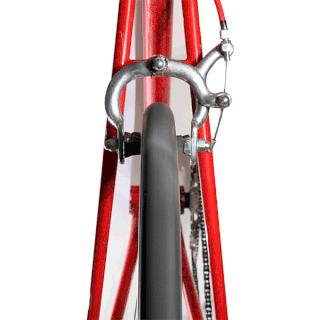 W
WA bicycle brake reduces the speed of a bicycle or prevents it from moving. The three main types are: rim brakes, disc brakes, and drum brakes.
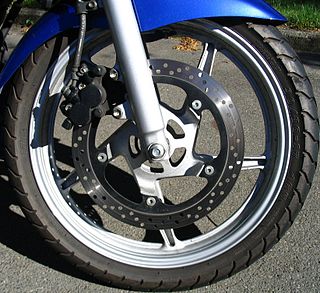 W
WA brake is a mechanical device that inhibits motion by absorbing energy from a moving system. It is used for slowing or stopping a moving vehicle, wheel, axle, or to prevent its motion, most often accomplished by means of friction.
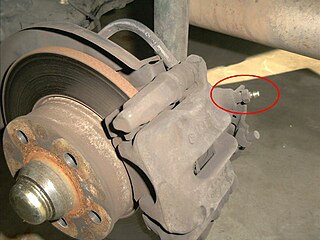 W
WBrake bleeding is the procedure performed on hydraulic brake systems whereby the brake lines are purged of any air bubbles. This is necessary because, while the brake fluid is an incompressible liquid, air bubbles are compressible gas and their presence in the brake system greatly reduces the hydraulic pressure that can be developed within the system. The same methods used for bleeding are also used for brake flushing or purging, where the old fluid is replaced with new fluid, which is necessary maintenance.
 W
WBrake cleaner, often also called parts cleaner, is a mostly colorless cleaning agent, mainly used for cleaning the brake disks, the engine compartment and underfloor of motor vehicles. An important feature is that the brake cleaner leaves no residue after the solvents evaporate.
 W
WBrake linings are the consumable surfaces in brake systems, such as drum brakes and disc brakes used in transport vehicles.
 W
WA brake shoe is the part of a braking system which carries the brake lining in the drum brakes used on automobiles, or the brake block in train brakes and bicycle brakes. A device that is put on a track to slow down railroad cars is also called brake shoe.
 W
WBraking distance refers to the distance a vehicle will travel from the point when its brakes are fully applied to when it comes to a complete stop. It is primarily affected by the original speed of the vehicle and the coefficient of friction between the tires and the road surface, and negligibly by the tires' rolling resistance and vehicle's air drag. The type of brake system in use only affects trucks and large mass vehicles, which cannot supply enough force to match the static frictional force.
 W
WA compression release engine brake, compression brake, or decompression brake, frequently called a Jacobs brake or Jake Brake, is an engine braking mechanism installed on some diesel engines. When activated, it opens exhaust valves to the cylinders, right before the compression stroke ends, releasing the compressed gas trapped in the cylinders, and slowing the vehicle.
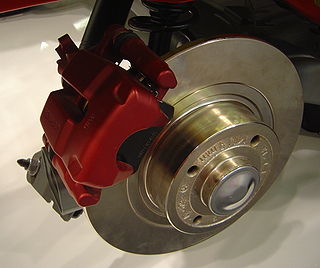 W
WA disc brake is a type of brake that uses the calipers to squeeze pairs of pads against a disc or a "rotor" to create friction. This action slows the rotation of a shaft, such as a vehicle axle, either to reduce its rotational speed or to hold it stationary. The energy of motion is converted into waste heat which must be dispersed.
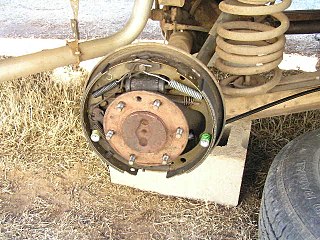 W
WA drum brake is a brake that uses friction caused by a set of shoes or pads that press outward against a rotating cylinder-shaped part called a brake drum.
 W
WElectronically controlled brake (ECB) developed by Toyota Motor Corporation initially for its hybrid and Lexus models, is the world's first production brake-by-wire braking system. The ECB went on sale in Japan in June 2001, first appearing on the Toyota Estima hybrid, and making its North American debut with the launch of the Lexus RX 400h SUV in April 2005. The ECB is an integral part of the company's Vehicle Dynamics Integrated Management stability control system, by allowing for automatic brake adjustments, which work in conjunction with variable gear-ratio electric power steering systems.
 W
WAn engineered materials arrestor system, engineered materials arresting system (EMAS), or arrester bed is a bed of engineered materials built at the end of a runway to reduce the severity of the consequences of a runway excursion. Engineered materials are defined in FAA Advisory Circular No 150/5220-22B as "high energy absorbing materials of selected strength, which will reliably and predictably crush under the weight of an aircraft". While the current technology involves lightweight, crushable concrete blocks, any material that has been approved to meet the FAA Advisory Circular can be used for an EMAS. The purpose of an EMAS is to stop an aircraft overrun with no human injury and minimal aircraft damage. The aircraft is slowed by the loss of energy required to crush the EMAS material. An EMAS is similar in concept to the runaway truck ramp or race circuit gravel trap, made of gravel or sand. It is intended to stop an aircraft that has overshot a runway when there is an insufficient free space for a standard runway safety area (RSA). Multiple patents have been issued on the construction and design on the materials and process.
 W
WA hydraulic brake is an arrangement of braking mechanism which uses brake fluid, typically containing glycol ethers or diethylene glycol, to transfer pressure from the controlling mechanism to the braking mechanism.
 W
WAn inboard brake is an automobile technology wherein the disc brakes are mounted on the chassis of the vehicle, rather than directly on the wheel hubs. Its main advantages are twofold: a reduction in the unsprung weight of the wheel hubs, as this no longer includes the brake discs and calipers; and braking torque is applied directly to the chassis, rather than being transferred to it through the suspension arms.
 W
WHydropneumatic suspension is a type of motor vehicle suspension system, designed by Paul Magès, invented by Citroën, and fitted to Citroën cars, as well as being used under licence by other car manufacturers, notably Rolls-Royce, Maserati and Peugeot. It was also used on Berliet trucks and has more recently been used on Mercedes-Benz cars, where it is known as Active Body Control. The Toyota Soarer UZZ32 "Limited" was fitted with a fully integrated four-wheel steering and a complex, computer-controlled hydraulic Toyota Active Control Suspension in 1991. Similar systems are also widely used on modern tanks and other large military vehicles. The suspension was referred to as oléopneumatique in early literature, pointing to oil and air as its main components.
 W
WHydropneumatic suspension is a type of motor vehicle suspension system, designed by Paul Magès, invented by Citroën, and fitted to Citroën cars, as well as being used under licence by other car manufacturers, notably Rolls-Royce, Maserati and Peugeot. It was also used on Berliet trucks and has more recently been used on Mercedes-Benz cars, where it is known as Active Body Control. The Toyota Soarer UZZ32 "Limited" was fitted with a fully integrated four-wheel steering and a complex, computer-controlled hydraulic Toyota Active Control Suspension in 1991. Similar systems are also widely used on modern tanks and other large military vehicles. The suspension was referred to as oléopneumatique in early literature, pointing to oil and air as its main components.
 W
WA line lock is a device that allows the front brakes to lock independently of the rear brakes via a switch. The device is an electric solenoid that controls a valve which allows the brakes to be controlled individually. This allows the front brakes to be locked and the rear brakes to be open, and allows the driver to spin the rear wheels without wasting the rear brakes. This method is referred to as line lock and is popular among enthusiasts who like to do burnouts.
 W
WAircraft braking systems include:Aircraft disc brakes in the landing gear, used to brake the wheels while touching the ground. These brakes are operated hydraulically or pneumatically. In most modern aircraft they are activated by the top section of the rudder pedals. In some older aircraft the bottom section is used instead. Levers are used in a few aircraft. Most aircraft are capable of differential braking. Thrust reversers, that allow thrust from the engines to be used to slow the aircraft. Air brakes, dedicated flight control surfaces that work by increasing drag. Large drogue parachutes, used by several former and current military and civilian aircraft and in the Space Shuttle.
 W
WDunlop's Maxaret was the first anti-lock braking system (ABS) to be widely used. Introduced in the early 1950s, Maxaret was rapidly taken up in the aviation world, after testing found a 30% reduction in stopping distances, and the elimination of tyre bursts or flat spots due to skids. Experimental fittings on cars and motorcycles demonstrated mixed performance, and ABS systems would not appear on mainstream, non sporting cars until the 1970s when electronic controls matured.
 W
WNissin Kogyo is a Japanese automotive parts company that makes vehicle braking systems and aluminium products. The company was founded in 1953 and is listed on the first section Tokyo Stock Exchange. As of March 2017, the company had 1.54 billion dollars in revenue and 9,557 employees. Honda Motor Company is the largest shareholder, owning 34.6 percent of total shares.
 W
WIn road vehicles, the parking brake, also known as a handbrake or emergency brake (e-brake), is a mechanism used to keep the vehicle securely motionless when parked. Parking brakes often consist of a cable connected to two wheel brakes, which is then connected to a pulling mechanism. In most vehicles, the parking brake operates only on the rear wheels, which have reduced traction while braking. The mechanism may be a hand-operated lever, a straight pull handle located near the steering column or a foot-operated pedal located with the other pedals.
 W
WA parking pawl is a device fitted to a motor vehicle's automatic transmission that locks up the transmission when the transmission shift lever selector is placed in the Park position. "Park" is the first position of the lever in all cars sold in the United States since 1965 through SAE J915, and in most other vehicles worldwide.
 W
WA proportioning valve is a valve that relies on the statics to supply a reduced pressure to an output line.
 W
WA retarder is a device used to augment or replace some of the functions of primary friction-based braking systems, usually on heavy vehicles. Retarders serve to slow vehicles, or maintain a steady speed while traveling down a hill, and help prevent the vehicle from "running away" by accelerating down the hill. They are not usually capable of bringing vehicles to a standstill, as their effectiveness diminishes as vehicle speed lowers. They are usually used as an additional "assistance" to slow vehicles, with the final braking done by a conventional friction braking system. As the friction brake will be used less, particularly at higher speeds, their service life is increased, and since in those vehicles the brakes are air-actuated helps to conserve air pressure too.
 W
WA transmission brake or driveline parking brake is an inboard vehicle brake that is applied to the drivetrain rather than to the wheels.